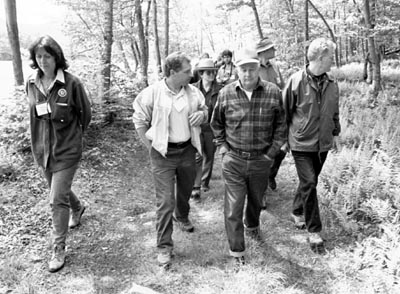|

|
|
Democrat Photo by
Ted Waddell
ON THE MONGAUP
TRAIL: Participants in a tour of the Catskill
Forest Preserve walk along a trail in the Mongaup
campground. From the left: Elaine Carpenter, a business
owner from Downsville; Jeffrey Rider, senior forester with
the Department of Environmental Conservation Region 3; Dave
Collins, a local farmer whose family has owned land
overlooking the Beaverkill for more than 150 years; and
Michael Austin of Austin PR, a public relations firm in
NYC.
|
Tourists Get a Taste Of
Catskills Preservation
By Ted Waddell
SULLIVAN COUNTY — June 20, 2000 -- On Wednesday, June 7, the Catskill
Center for Conservation and Development teamed up with the NYS
Department of Environmental Conservation (DEC) to conduct a day-long
tour of selected sites within Sullivan County which are part of the
Catskill Forest Preserve.
In Friday’s edition, we focused on the tour and what participants
learned from their DEC guides. Today, we present a look at the Catskill
Forest Preserve and the Catskill Forest Preserve Public Access Plan of
1999. The Catskill Center for Conservation and Development is a
non-profit organization headquartered in Arkville that promotes
environmental education and awareness in six NYS counties: Delware,
Greene, Otsego, Schoharie, Sullivan and Ulster.
The mission of the NYS DEC is “to conserve, improve and protect New
York’s natural resources and environment and control water, land and
air pollution, in order to enhance the health, safety and welfare of
the people of the state and their overall economic and social
well-being.”
The Catskill Forest Preserve was created on May 15, 1885 when Governor
David B. Hill signed legislation requiring that “All the lands now
owned or which may hereafter be acquired by the State of New York (in
three Catskill and 11 Adirondack counties) be forever kept as wild
forest lands. They shall not be sold nor shall they be leased or taken
by any person or corporation, public or private.”
The Catskill Park was created by Chapter 233 of the NYS Laws of 1904,
encompassing 576,120 acres. Today, the park covers 1,102 square miles
(705,500 acres).
According to DEC statistics, an estimated 530,000 people visited the
Catskill Park in 1996.
In 1985, the DEC completed a Catskill Park State Land Master plan which
implemented a series of recommendations made by the Catskill Study
Commission.
The NYS Legislature authorized development of the state’s first Open
Space Conservation Plan in 1990. Two years later, the DEC and Office of
Parks, Recreation and Historic Preservation (OPRHP), working together
with nine regional citizen advisory committees, completed the first
Open Space Plan.
The plan proposed which open spaces should be saved for NYS’s future,
and described how open space resources can be conserved and managed by
sensible, cost effective methods.
The plan identified the forest preserve as a major resource category,
and established a mechanism for adding Catskill Forest Preserve lands
and acquiring conservation easements within the park. It specifically
proposed a dedicated funding source to implement many of the
recommendations.
In 1993, the NYS Environmental Protection Act was passed. The act
established the Environmental Protection Fund (EPF) for State Open
Space Conservation Projects and other related
conservation/environmental protection projects.
In the 1999 plan, DEC said, “The Catskill Forest Preserve Public
Access Plan treats, for the first time, the many parcels of state land
within the Catskill Park as parts of a single Catskill Forest Preserve.”
A series of recommended actions for this unique approach includes a
balanced approach to the development of appropriate access and
recreational opportunities on the forest preserve… a system of
information about the natural, cultural, educational and economic
values… and the creation of new recreational opportunities and
programs, “in a way that will enhance and protect the scenic travel
corridors of the Catskill Park and take advantage of opportunities to
form partnerships with Catskill governments, communities and
businesses.”
The three main use classifications in the Catskill Forest Preserve are
wilderness, wild forest and intensive. The wilderness classification is
the most restrictive. In wild forest areas, higher levels of
recreational use are allowed, while intensive use areas include
campgrounds.
For information about the Catskill Forest Preserve, call DEC foresters
Jeff Rider at 256-3083 or Bill Rudge at 256-3111, at the NYS DEC Region
3 headquarters in New Paltz.
|

